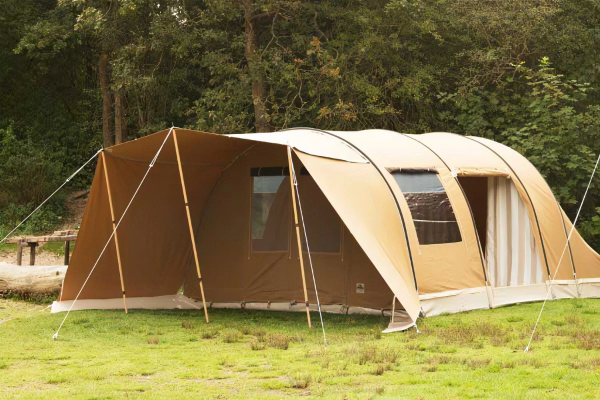Tunnel tents are popular among campers for their spacious design and ease of setup. In this article, we’ll explore what tunnel tents are, their features, benefits, and how to choose the right one for your camping needs. We’ll also compare tunnel tents to other types of tents and provide tips for using and maintaining them.
What Is a Tunnel Tent?
A tunnel tent is a type of tent characterized by its elongated shape, resembling a tunnel. It is designed with a series of flexible poles that create a semi-circular frame. The tent fabric is draped over these poles, forming a tunnel-like structure.
See Also: What Is the Best Camping Stove for Families
Features of Tunnel Tents
Shape and Structure: Tunnel tents have a long, tubular shape, providing ample headroom and interior space. The semi-circular poles create a sturdy frame.
Poles: Typically, tunnel tents use flexible poles made from materials like fiberglass, aluminum, or carbon fiber. These poles are lightweight yet durable.
Fabric: The tent fabric is usually made from materials such as nylon or polyester, which are lightweight, water-resistant, and durable.
Ventilation: Tunnel tents often include multiple vents and windows to ensure good airflow, reducing condensation inside the tent.
Vestibules: Many tunnel tents come with vestibules or extended porch areas, providing extra space for storing gear and equipment.
Ease of Setup: Tunnel tents are known for their straightforward setup process. The poles are threaded through sleeves or clipped to the tent fabric, making assembly quick and easy.
Benefits of Tunnel Tents
Spacious Interior: The tunnel shape provides generous headroom and floor space, making it comfortable for campers to move around inside.
Stability: Tunnel tents are designed to withstand strong winds and adverse weather conditions. The flexible poles and aerodynamic shape enhance stability.
Lightweight: Despite their size, tunnel tents are relatively lightweight, making them suitable for backpacking and hiking trips.
Versatility: Tunnel tents come in various sizes, accommodating solo campers to large families. They are suitable for a range of camping activities, from weekend getaways to extended expeditions.
Choosing the Right Tunnel Tent
Capacity: Consider the number of people who will be using the tent. Tunnel tents are available in various capacities, from one-person models to large family tents.
Weight: If you plan to carry the tent for long distances, choose a lightweight model. Check the weight of the tent, including poles and accessories.
Weather Resistance: Look for a tent with good weather resistance, including a waterproof rainfly and sturdy poles. Check the tent’s hydrostatic head rating, which indicates its waterproof capabilities.
Ventilation: Ensure the tent has adequate ventilation to prevent condensation buildup. Look for tents with multiple vents and mesh windows.
Vestibules and Storage: Consider the need for extra storage space. Tents with vestibules provide additional room for gear and equipment.
Ease of Setup: Choose a tent with a straightforward setup process. Tunnel tents with color-coded poles and clear instructions are easier to assemble.
Tunnel Tents vs. Other Types of Tents
Tunnel Tents vs. Dome Tents: Dome tents are another popular option. They have a rounded shape and are supported by intersecting poles. While dome tents are easier to set up and generally lighter, tunnel tents offer more interior space and stability in strong winds.
Tunnel Tents vs. Cabin Tents: Cabin tents have vertical walls and offer maximum interior space. They are ideal for family camping trips but are bulkier and heavier than tunnel tents. Tunnel tents strike a balance between space and portability.
Tunnel Tents vs. Geodesic Tents: Geodesic tents have multiple intersecting poles that create a strong, stable structure. They are designed for extreme weather conditions and mountaineering. Tunnel tents are more suitable for general camping and provide better space utilization.
Tips for Using Tunnel Tents
Site Selection: Choose a flat, level campsite free of sharp objects that could damage the tent floor. Consider wind direction when pitching the tent.
Pitching the Tent: Follow the manufacturer’s instructions for setup. Ensure the tent is taut and securely anchored with stakes and guy lines.
Ventilation: Open vents and windows to maintain good airflow inside the tent. This helps reduce condensation and keeps the interior comfortable.
Storage and Maintenance: Store the tent in a cool, dry place when not in use. Clean and dry the tent thoroughly before packing it away to prevent mold and mildew.
Weather Protection: Use a footprint or groundsheet to protect the tent floor from moisture and abrasion. In heavy rain, ensure the rainfly is properly attached and taut.
Conclusion
Tunnel tents are a versatile and practical choice for campers seeking a balance of space, stability, and ease of setup. With their spacious interiors, lightweight design, and weather-resistant features, tunnel tents are suitable for a wide range of camping activities. By considering factors such as capacity, weight, weather resistance, and ventilation, you can choose the right tunnel tent for your needs. Whether you’re embarking on a solo adventure or a family camping trip, a tunnel tent can provide a comfortable and reliable shelter in the great outdoors.

